Artificial snow “no panacea” for resorts
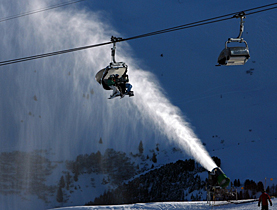
Snowmaking machines make economic sense for some alpine resorts but should not be held up as a cure for countering climate change, a study has found.
The research by the Federal Institute of Technology in Lausanne, in cooperation with the National Centres of Competence in Research, is believed to be the first scientific study into the economic impact of artificial snowmaking on resorts.
“Snowmaking facilities are often presented as a central measure in adapting to climate change,” Camille Gonseth, who conducted the study, told swissinfo. “My results show that snowmaking cannot be considered a panacea.”
The study of Swiss resorts was based on results from the 2003-2005 winter seasons and concluded that the overall economic impact was positive, but decreased when investment in artificial snow systems increased.
Companies profited from snowmaking but any resorts with an artificial snow capacity above 30 kilometres of slopes stopped benefiting once the financial and depreciation costs were taken into account. The average artificial capacity in Swiss resorts is 20 kilometres.
At the other end of the spectrum, Gonseth says low-lying and mid-range resorts are going to have to face the biggest challenge under climate change but could not consider artificial snow as a viable way forward economically.
Smaller resorts, often located in the low-lying areas, also found it harder to absorb the set-up, maintenance, labour and investment costs associated with snowmaking systems, he argues.
“These are costs that are there every year,” Gonseth said. “It is the big businesses that actually cover these costs better with extra profits they earn from snowmaking.”
Economic limitations
Gonseth’s research cites several studies that agreeing the Swiss ski industry will suffer from the impacts of climate change and have to start adapting to new weather patterns.
While increasing temperatures spell good news for summer tourism to the Alps, resorts would have to adapt by finding ways of continuing snow-dependent sports in mountain regions in winter.
He notes that snowmaking is one of the most important adaptation measures available but warns against relying on it.
“We see that there are economic limits. The predictions I have done show that for a certain number of businesses the more they invest in snowmaking, the more they can expect their economic results to diminish,” said Gonseth.
“My conclusion is that you should not count on snowmaking alone to adapt to climate change.”
Not just altitude
Leo Jeker, former director of the lift company in Savognin in southeastern Switzerland, told swissinfo however that location was more important than altitude.
“The very low regions will have to decide how to invest for the future. But one can’t generalise about where and when to make artificial snow. It’s not just the height of the region that counts. It depends where the regions lie [geographically],” he said on Friday.
“I know some places at only 600 metres that don’t have a problem and other places at 1,000 metres that do.”
In 1978 Jeker became the first person in Switzerland to purchase snowmaking equipment on a large scale.
swissinfo, Jessica Dacey
Camille Gonseth’s study is entitled “Adapting ski area operations to a warmer climate in the Swiss Alps through snowmaking investments and efficiency improvements”.
It found that around 1,400 kilometres – 19 per cent – of total slope area in Switzerland was set up for artificial snow cover in 2005.
Under the poor snow conditions of the 2003-2004 season, 69.5 per cent of Swiss companies operating more than 15 kilometres of ski slopes would have increased their net income with a one kilometre increase in snowmaking facilities.
Total cantonal and federal investment in snowmaking across Switzerland in 2005 was SFr12.5 million ($11.6 million). The study found that artificial snow could cover 18-22 per cent of slope area in the three most important ski regions in cantons Valais, Graubünden and Bern.
Ski operators in Fribourg, Vaud, Ticino and St Gallen were the most dependent on cantonal authorities for investment in snowmaking systems. Bernese resorts were the least dependent on cantonal authorities.

In compliance with the JTI standards
More: SWI swissinfo.ch certified by the Journalism Trust Initiative

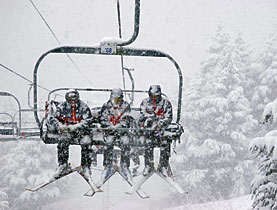
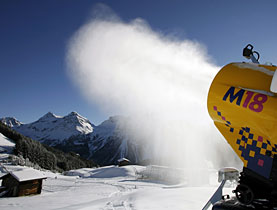
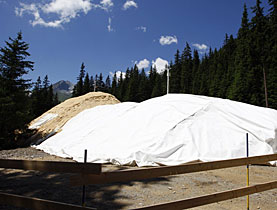
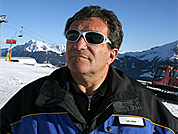
You can find an overview of ongoing debates with our journalists here. Please join us!
If you want to start a conversation about a topic raised in this article or want to report factual errors, email us at english@swissinfo.ch.